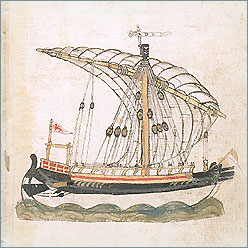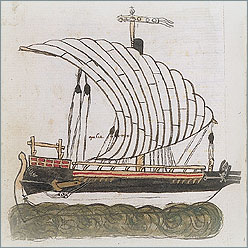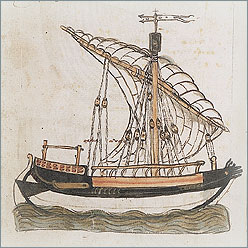Ships and Shipbuilding: Galleys
From ancient times, oar-powered galleys were used primarily as warships. Their long and slender shape made them fast and maneuverable and, although sails were used to conserve the strength of the crew whenever possible, oars allowed galley commanders to come and go and maneuver in battle independently of the wind.
After 1300, Venetian shipwrights began to adapt the military galley for commerce, but the use of galleys for trade had several disadvantages. Commercial galleys were bigger than military galleys and therefore even more expensive to build. Large crews made them expensive to operate. For their size, they had a relatively small carrying capacity of approximately 250 to 350 tons.
The only way to make a profit with such ships was to carry low-bulk goods of extremely high values, such as pepper, ginger, and other spices; finished cloth; and precious metals. Rich cargoes like these required a considerable investment of capital on the part of merchants. They also attracted the attention of pirates and rival powers.
With respect to these last two problems, galleys offered two advantages. Large crews meant that galleys could generally defend themselves against pirates and other enemies, especially when sailing in a convoy. The use of oars in addition to sails meant commercial galleys could generally keep to a regular schedule. This regularity allowed merchants to plan their loans and investments, predict their profits, and plan the redeployment of their capital to make even more money. The combination of security and regularity was attractive to many investors, just as it would be today.
Galley of Flanders
Michael's treatise on shipbuilding describes the military and commercial galleys on which he sailed every year for more than 40 years.
The first ship he describes is the commercial galley of Flanders (135a-147b; ![]() 135b, 138b, 139a, 139b, 140b, 143a, 144b, 145b, 147b). These were the largest galleys used in Michael's time. Their size was in part a response to the added dangers posed by sailing in the treacherous Atlantic, where bigger meant safer; in part a response to the length of the journey. If merchants were going to travel all the way to London or Bruges, they wanted to carry as much cargo as possible to pay for the effort.
135b, 138b, 139a, 139b, 140b, 143a, 144b, 145b, 147b). These were the largest galleys used in Michael's time. Their size was in part a response to the added dangers posed by sailing in the treacherous Atlantic, where bigger meant safer; in part a response to the length of the journey. If merchants were going to travel all the way to London or Bruges, they wanted to carry as much cargo as possible to pay for the effort.
Once developed, the galley of Flanders was used from time to time on the other commercial routes, and the term galia grossa, or "large galley," came to be used to refer to commercial galleys in general.
Michael opens his description of the galley of Flanders with a paragraph stating that he will tell the reader everything he needs to know to make and equip such a ship. On the first page he gives the following principal dimensions.
| Dimension | Venetian measures | Meters | U.S. feet |
|---|---|---|---|
| Length on the deck | 23 paces, 3.5 feet | 36.9 | 121.06 |
| Breadth | 17.5 feet | 6.12 | 20.11 |
| Height | 7 feet, 10 inches | 2.74 | 9.0 |
Michael then gives a long list of measurements relating to the stem, stern, midship frame, wales, ribbands, hatches, outrigger, and more. The list of measurements is followed by a considerable amount of information about equipment including masts, spars, boats, anchors, and cables. Also included is a great deal of information about parts of the rigging, including sails, shrouds, and stays.
The outstanding feature of this section of the manuscript is the number of colored illustrations that Michael provides. While it is possible that Michael painted the illustrations himself, this has not been proven. It is certain that he planned them and would have supervised anyone else who did the actual illustrations. The drawings show the hull on stocks, the completed hull, and the completed ship under full sail at sea. Other pictures show the mast and spars, ropes, anchors, and rudders. (See the toolkit to learn more about equipment.)
Undoubtedly the most important drawings in the manuscript are those related to design and construction. They are the earliest technical drawings related to hull design in existence.
Galley of Romania
The second ship Michael describes is a galley of Romania (148b-156a). These were the galleys sent on the voyage to Constantinople and to Black Sea ports such as Tana and Trebizond.
As he did with the galley of Flanders, Michael begins this description by saying he will teach the reader everything he needs to know to build and equip the galley of Romania. Unfortunately, he forgot to give the breadth while listing the overall dimensions:
| Dimension | Venetian measures | Meters | U.S. feet |
|---|---|---|---|
| Length on the deck | 23 paces | 36.72 | 120.48 |
| Breadth | ___ | ___ | ___ |
| Height | 7 feet | 2.57 | 8.43 |
These dimensions show that the galley of Romania was only slightly smaller than the galley of Flanders. The main difference between them may have been the shape of the hull, since Michael says there are five identical midship frames in the galley of Romania compared to only four for the galley of Flanders. This would have affected all of its various curves.
The rest of Michael's description generally follows the same order and covers the same material as his description of the galley of Flanders. This text, however, is not as complete. For example, Michael lists the masts, spars, sails, and various lines and cables that are needed, but the value for the length of these items is often left blank. This suggests that Michael either intended to look up or even calculate the required values and then finish his text, but never did, or else the dimensions may have been missing in the original from which he copied.
Michael did, however, complete most of the illustrations for this section of the manuscript. They cover the same range of material as the illustrations of the galley of Flanders, except that he included only one drawing related to design and construction. Mysteriously, it is much cruder than the same drawing he provided for the galley of Flanders (![]() 145b), and the dimensions that should have been written on it are missing.
145b), and the dimensions that should have been written on it are missing.
Light galley
The third galley Michael describes is a galia sottil, or "light galley" (157b-163a; ![]() 162b). This is the military galley in which Michael sailed so often with the Venetian Guard.
162b). This is the military galley in which Michael sailed so often with the Venetian Guard.
Light galleys were smaller and narrower than commercial galleys, but because the first two pages of this section of the manuscript are missing, we don't know the length, breadth, or height that Michael would have included. The section describing the placement of the wales is also missing.
Otherwise, the text generally follows the same pattern and covers the same material that Michael described for the galleys of Flanders and Romania. It includes a discussion of the location of the ribbands along the frames and proceeds to a discussion of masts, spars, sails, and rigging. Michael devotes far fewer pages to the light galley than he does to the commercial galleys.
Once again, many of the dimensions for the masts, yards, and boats are missing.
And while Michael did complete almost all of the drawings he planned for the light galley, there is a further mystery. One of the drawings he includes concerning construction is as clear as the equivalent drawing for the galley of Flanders (![]() 145b). But three of the other drawings are comparatively crude, and their dimensions are missing.
145b). But three of the other drawings are comparatively crude, and their dimensions are missing.
< Introduction | Sailing Ships >














